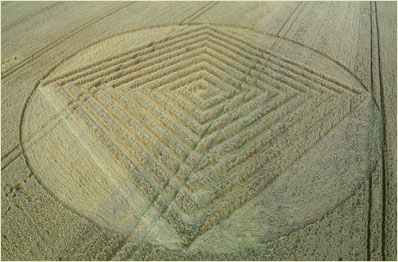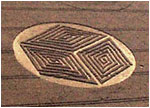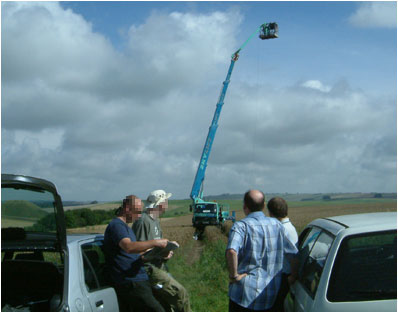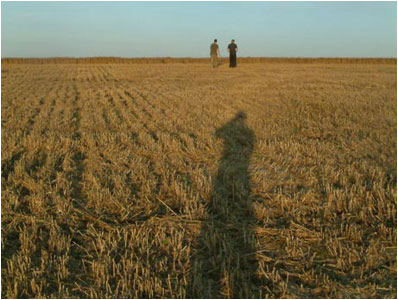 | 







 |  |

 |  |  | 


At the beginning of August 2004 circlemakers John Lundberg, Rod Dickinson and Wil Russell were asked by National Geographic TV to create a demonstration formation in daylight opposite Silbury Hill in Wiltshire for a documentary on the crop circle phenomenon. We decided to create a 200ft formation incorporating a square spiral. Until now square spirals have not appeared out in the fields, probably because unlike a circular spiral - which is relatively easy to accomplish with the right tools - a square spiral is a complex geometric form and difficult to create accurately. At our suggestion National Geographic rigged up a 120ft crane at the side of the field and shot time-lapse footage of the formation being created. It took 3 of us a very sedate 5 hours to create, with lots of breaks in construction
for filming.

Above: The completed formation shot from the 120ft crane.
 As stated above as far as we were aware at the time, no previous crop circle design had incorporated a square spiral, or water snake as it is sometimes
called. But in one of those cosmic coincidences that happen
frequently in a subject like this, we've now seen reports of a square spiral formation at Woodingdean in East Sussex (pictured right) which appeared a few days before we created ours on camera, although unlike our formation its construction seems somewhat haphazard. As stated above as far as we were aware at the time, no previous crop circle design had incorporated a square spiral, or water snake as it is sometimes
called. But in one of those cosmic coincidences that happen
frequently in a subject like this, we've now seen reports of a square spiral formation at Woodingdean in East Sussex (pictured right) which appeared a few days before we created ours on camera, although unlike our formation its construction seems somewhat haphazard.

Above: The diagrams we used to create the formation.

Above: Circlemakers Rod Dickinson and John Lundberg (left) with Wessex Sceptics Dr Robin Allen and Chris Nash who were also contributing to the documentary.

Above: John Lundberg displaying one of the 'stalk stompers' used to create the formation in front of the combine that is about to harvest the crop circle.

Above: The formation was harvested after we finished filming and we went in
to see just how much of the downed crop the combine could pick up.
There wasn't any crop left, the combine managed to pick up 100% of
the downed crop, which - as we've always maintained - proves that the
act of creating a crop circle does not lead to loss of crop. Only
after a formation is heavily visited is the crop trampled and
unrecoverable...
Photos: John Lundberg, Wil Russell and David Russell.
 |  |  |   | |





